
Valdosaurus is a genus of bipedal herbivorous iguanodont ornithopod dinosaur found on the Isle of Wight and elsewhere in England, Spain and possibly also Romania. It lived during the Early Cretaceous.

The Oxford Clay is a Jurassic marine sedimentary rock formation underlying much of southeast England, from as far west as Dorset and as far north as Yorkshire. The Oxford Clay Formation dates to the Jurassic, specifically, the Callovian and Oxfordian ages, and comprises two main facies. The lower facies comprises the Peterborough Member, a fossiliferous organic-rich mudstone. This facies and its rocks are commonly known as lower Oxford Clay. The upper facies comprises the middle Oxford Clay, the Stewartby Member, and the upper Oxford Clay, the Weymouth Member. The upper facies is a fossil poor assemblage of calcareous mudstones.

Camptosaurus is a genus of plant-eating, beaked ornithischian dinosaurs of the Late Jurassic period of western North America and possibly also Europe. The name means 'flexible lizard'.
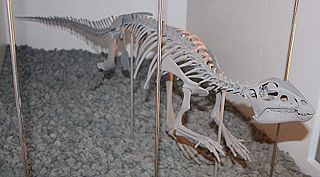
Hypsilophodontidae is a traditionally used family of ornithopod dinosaurs, generally considered invalid today. It historically included many small bodied bipedal neornithischian taxa from around the world, and spanning from the Middle Jurassic until the Late Cretaceous. This inclusive status was supported by some phylogenetic analyses from the 1990s and mid 2000s, although there have also been many finding that the family is an unnatural grouping which should only include the type genus, Hypsilophodon, with the other genera being within clades like Thescelosauridae and Elasmaria. A 2014 analysis by Norman recovered a grouping of Hypsilophodon, Rhabdodontidae and Tenontosaurus, which he referred to as Hypsilophodontia. All other analyses from around the same time have instead found these latter taxa to be within Iguanodontia.
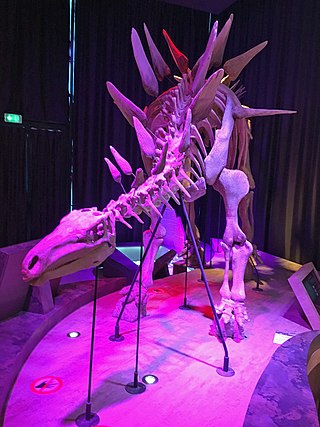
Lexovisaurus is a genus of stegosaur from mid-to-Late Jurassic Europe, 165.7-164.7 mya. Fossils of limb bones and armor fragments have been found in middle to late Jurassic-aged strata of England and France.
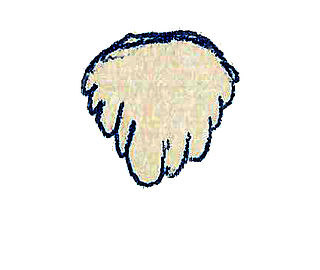
Alocodon is a genus of ornithischian dinosaur known from multiple teeth from the Middle or Late Jurassic Cabaços Formation of Portugal, and also the Forest Marble and Chipping Norton Formations of England. A single species is known, A. kuehnei.
Trimucrodon is a genus of ornithischian dinosaur from the Late Jurassic Lourinhã Formation of Portugal. The type, and currently only, species is T. cuneatus.

Cumnoria is a genus of herbivorous iguanodontian dinosaur. It was a basal iguanodontian that lived during the Late Jurassic period in what is now Oxfordshire, United Kingdom.
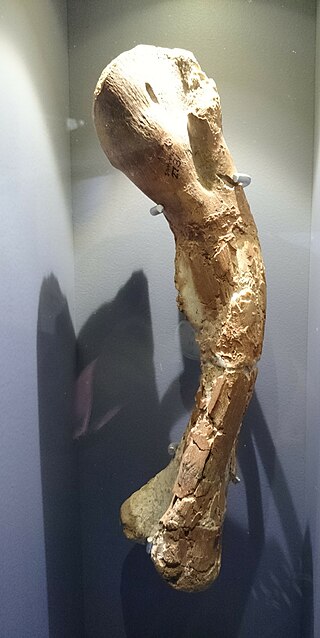
Kangnasaurus is a genus of iguanodontian ornithopod dinosaur found in supposedly Early Cretaceous rocks of South Africa. It is known from a tooth and possibly some postcranial remains found in the early-Aptian Kalahari Deposits Formation. It was probably similar to Dryosaurus.

Nanosaurus is the name given to a genus of neornithischian dinosaur that lived about 155 to 148 million years ago, during the Late Jurassic-age. Its fossils are known from the Morrison Formation of the south-western United States. The type and only species, Nanosaurus agilis, was described and named by Othniel Charles Marsh in 1877. The taxon has a complicated taxonomic history, largely the work of Marsh and Peter M. Galton, involving the genera Laosaurus, Hallopus, Drinker, Othnielia, and Othnielosaurus, the latter three now being considered to be synonyms of Nanosaurus. It had historically been classified as a hypsilophodont or fabrosaur, types of generalized small bipedal herbivore, but more recent research has abandoned these groupings as paraphyletic and Nanosaurus is today considered a basal member of Neornithischia.
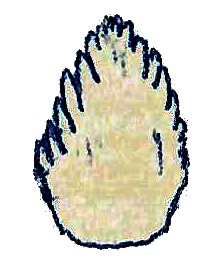
Phyllodon was a genus of small ornithischian dinosaur from the Kimmeridgian-aged Upper Jurassic Camadas de Guimarota Formation of Leiria, Portugal and possibly also the Bathonian-aged Chipping Norton Limestone of England. It may have been closely related to contemporaneous dinosaurs in North America.
Gongbusaurus is a genus of ornithischian, perhaps ornithopod, dinosaur that lived between about 160 and 157 million years ago, in the Late Jurassic period. A small herbivore, it is very poorly known. Two species have been assigned to it, but as the original name is based on teeth, there is no concrete evidence to connect the two species. Its fossils have been found in China.

Cedrorestes is a genus of iguanodontian dinosaur from the Early Cretaceous of Utah. It is based on an incomplete skeleton which was found in the Valanginian-age Yellow Cat Member of the Cedar Mountain Formation.

Dryosauridae was a family of primitive iguanodonts, first proposed by Milner & Norman in 1984. They are known from Middle Jurassic to Early Cretaceous rocks of Africa, Europe, and North America.

Elrhazosaurus is a genus of basal iguanodontian dinosaur, known from isolated bones found in Early Cretaceous rocks of Niger. These bones were initially thought to belong to a species of the related dryosaurid Valdosaurus, but have since been reclassified.
The Kalahari Deposits is an Early Cretaceous (Aptian) geologic formation in South Africa. Dinosaur remains diagnostic to the genus level are among the fossils that have been recovered from the formation. The depositional environment is described as a crater lake where poorly lithified, concretionary conglomerate and volcaniclastic, intraclastic, calcareous mudstone were deposited under quiet subaqueous conditions, probably a "crater-fill succession above an olivine-melilitie intrusion".
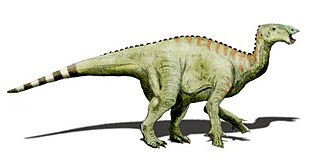
Hypselospinus is a genus of iguanodontian dinosaur which was first described as a species of Iguanodon by Richard Lydekker in 1889, the specific name honouring William Henry Fitton.

Ankylopollexia is an extinct clade of ornithischian dinosaurs that lived from the Late Jurassic to the Late Cretaceous. It is a derived clade of iguanodontian ornithopods and contains the subgroup Styracosterna. The name stems from the Greek word, “ankylos”, mistakenly taken to mean stiff, fused, and the Latin word, “pollex”, meaning thumb. Originally described in 1986 by Sereno, a most likely synapomorphic feature of a conical thumb spine defines the clade.
























